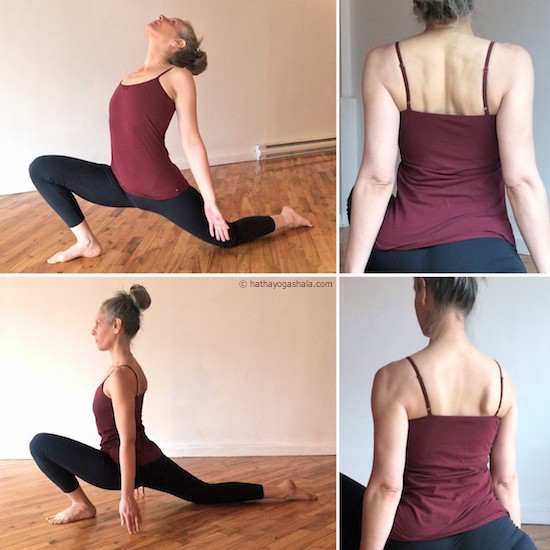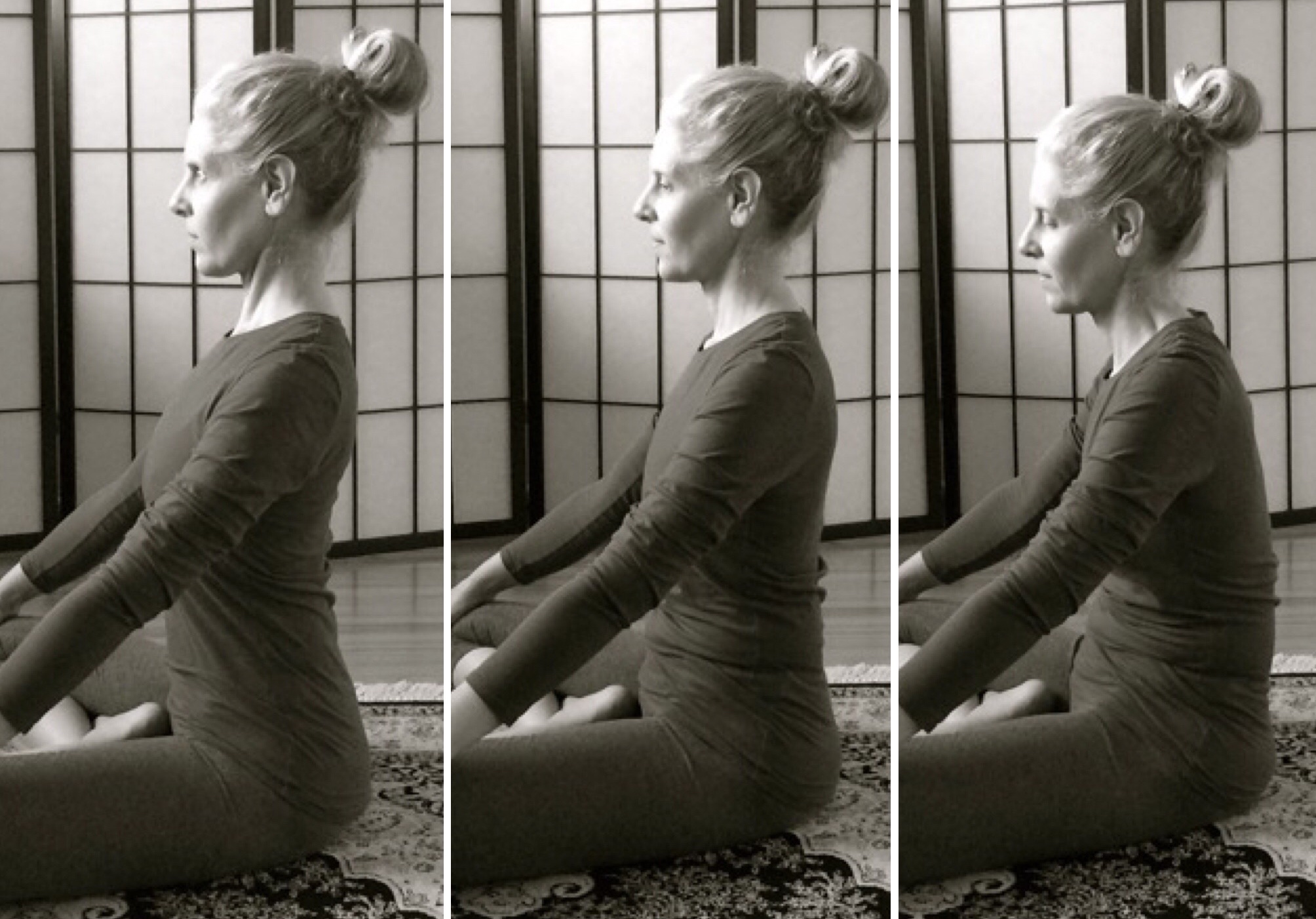Yielding

Drivers are taught to yield to oncoming traffic and to be prepared to stop if necessary. To merge is to permit what is already flowing to have precedence over our wish to continue as desired. Both require adaptability and skill. If we impose our beliefs and desires and not see clearly what is actually going on, we obstruct the way. We may wind up not responding appropriately to reality and as a result cause a traffic jam or an accident. Anyone who has driven in India will understand the great importance of a quick and correct response on the road!
The concept of yielding can be good advice for life in general and can also be applied to our yoga practice. Similar principles are required in yoga, especially when arriving at advanced stages of Pranayama, the restraint of breath and the idea of Laya, merging and absorption with the Supreme Consciousness. However, right from the start we are working with our breath and posture and may notice our tendency to either collapse or to force ourselves upright. Both obstruct and are limiting. We all swing from one to the other to certain degrees and in various areas of the body. Our job is to find neutral, or the place of yield.

I first learnt these three terms while studying with Donna Farhi 18 years ago. To this day Propping, Collapsing and Yielding still appear in my daily observations of myself, students and everyone I encounter in general.
Propping refers to a puffing up of ourselves, a lifting of the heart into the throat and inflating the chest and ribs, the jaw or face. Its direction is upwards and outwards and can give a sense of power, high alertness, over-confidence, arrogance or pompousness. It is a forced and imposing stance of offence which at an extreme is used to induce fear and display strength and authority.
Collapsing refers to a sinking, has a downwards and inwards direction of the heart, and emits carrying a heavy burden, a lack of confidence, grieving or a sense of giving up. Life is either too hard to bear or it has been sucked out of us. It is a victim’s stance of defence and protection. It can also show a sense of weakness, spinelessness, or frailty in comparison to the more aggressive brute strength and firmness the propping displays. We are all victims of gravity and almost everyone will shrink, cave in and wither with age. Many who work at desks, on computers or play a musical instrument develop a caving in of the chest and rounded shoulders as well.
One is extroverted, the other introverted. One is taking in more than necessary, the other not taking in enough. One is inflated, the other deflated. One has the breath stuck up high in the chest, the other stuck down low in the belly. One is inhalation dominant, the other exhalation dominant. One appears hard and light while the other soft and heavy. One is overcompensating, the other has given up before trying. One can be high strung or emotionally unstable overachievers, the other depressed, melancholic underachievers. One is known to make the rules and the other to follow them. But is this really so? One may appear authoritarian or dominating but the other subservient one can be rigidly stuck in dogmatic ways and likes to have rules.
A ‘propper’ may be more gifted athletically but a ‘collapser’ may be more spiritually inclined. The idea is to invite both ways in moderation. We don’t want our forceful ambitions to bring us to harm or injury, nor do we want our weaknesses and insecurities to keep us stuck from getting things done.
A ‘collapser’ will have to prop themselves up to resist the collapse. A ‘propper’ will need to soften, trust and relax. Both are straining and compromise the internal organs, breath and spine. Both block anything or anyone from getting in, both are hiding something, both are masking reality. Both are trying to hold themselves up from the outside structure and both will need to find an internal support. Just like it’s much easier and faster to demolish something than it is to construct it, it can take at least twice as long for a ‘collapser’ to build up the strength and support they need.

Our entire life is a dance between the two sides of the same coin. We must be able to defend and confront when necessary but also know when to back down and choose our battles. A yoga practice helps to build a bridge between these polarities and pave a way for a steadier, more emotionally stable existence.
Yielding refers to the neutral place that resides in between prop and collapse. It is the internal support that maintains integrity to the spine and internal organs and allows for freedom of breath. It is the trust and faith one develops mentally and emotionally. No preferences taken, no threats lingering, no offence or defence needed. A smooth flow of unobstructed calmness in breath, body and mind. A merging with the gift of natural design, a uniting with our environment. Less effort is required in this space. Yielding can be firm but is able to bend without breaking. Adaptability is the key.
Our body postures have been constructed as coping mechanisms based on the history of events that flooded our lives, our inherent constitutions, as well as the initial mimicking of our parents’ postures. We can switch at various times between the two but we will always have one that is more natural and dominates who we are and how we have survived our life thus far. It is how we can be recognized walking down the street by those who know us. They see our gait, stance and mannerism which gets ingrained and difficult to change.
As teachers we observe the variety of postures that enter the studio. It is important not to try to change them so quickly. We don’t know what lies underneath that propping or collapsing spine. Numerous stories are unveiled over time of how this person came to hold such posture and we can not rush to judge or get them to shed it so quickly.
A life of abuse can cause someone to crumble under pressure but it can just as well create an inflated shield of protection. There can be a scared little boy hiding behind overdeveloped muscles and puffy chest just as much as there can be a raging woman trapped inside the sunken cavity and quiet demeanour. The propping can be an attempt to hide a true collapse. The collapse can be a method to torment and stubbornly resist expressing oneself.
There also doesn’t necessarily have to be any big traumatic drama involved. Children can grow very tall early on and were never taught to not slouch while eating or interacting with shorter friends. We could have suffered injuries or illnesses. We can be working in a job or playing a one-sided sport that is causing a distortion. Or we have simply made bad choices in furniture. We just don’t know and must allow the student to arrive at these conclusions in their own time. Point being, avoid rushing to assumptions about anyone based on their looks and posture before you are told the history of their life.
Going slowly is essential. We do not want to wake up a sleeping dragon before the student is prepared and ready to unlock that hidden treasure. By focusing on the basic exercises and observing our breath and posture will inevitably lead us to discover much deeper issues. But that is up to the student to tread the depth of those oceans, not the place of the teacher. If a student is unable to recognize something themselves then they are not ready or willing to. Period. It is not the teacher’s job to do otherwise. Pushing a student to just drop it and get over their ‘baggage’ runs the risk of losing them as your student or even worse, causing them to leave the practice altogether.
Stories are just stories and memories are inaccurate and unreliable. By focusing on the task at hand, like a lunge, keeps us with the detailed work that is necessary in the present time. The physical activity is hard enough and we can quickly be confronted with our blocks. But these restrictions usually lie in the way our mind perceives. The real yoga is mental, dealing with our aches, pains, fears, panics, ambitions, comparisons, complaints, self-esteem and trust issues. These trickier issues will be addressed gradually and only once the student is ready and willing to expose themselves through opening up, sharing, asking questions and getting involved with the learning process.

Some students come to class not to learn but to escape. They are quite satisfied remaining quiet, hiding out and following instructions blindly, going home none the wiser. A teacher must wait for them to engage or else both waste energy. Problems can arise when students are not honest and do not share relevant information such as injuries, sicknesses or losses that occur. A skilled teacher may be able to see a problem but can not understand the meaning behind it. As my teacher says “you need to wait for them to tell you, otherwise it’s like breaking into their house and robbing them.”
The relationship between teacher and student happens over a long period of time and can be a very powerful and transformative process. The popular drop in classes and factory line teacher trainings can leave students open and vulnerable to experiencing things they can not comprehend or digest. They may leave class feeling raw or exposed with no support from the teacher after.
We are not teaching mere exercise in yoga. While changing our posture and breathing rhythm, we are tapping into deep psychological barriers with heavy traffic. Learning how to yield comes into play here. We are not looking to get rid of anything, we are seeking a merging, self-acceptance and a connection with the Divine.
What if we can meet our creator in a neutral stance? No one appreciates their door being forced open or busted down. Nor will the Supreme be able to hear the knocking if too faint. What if we seek to merge into Spirit effortlessly and unimpeded instead? This would require effort as well as humility. A yielding.
Would it create a life without traffic jams or accidents? Unlikely, but perhaps it would allow us to yield to these occurrences with less suffering, less “mini-me” involved. Yoga has little to do with ability in asana, any contortionist can get there. Yoga has more to do with how much we are able to expose of ourself, warts and all. How we can dispose of identifications and attachments to the stories that moulded us and constructed who we think we are. As Leonard Cohen said “the less of me there was, the happier I became”.
To get to Yoga demands we yield to a greater force, one that guides without trying to control or without giving up, without needing to be superior or inferior. Spirit has already deemed us worthy of existence, we just need to get out of the way and respond appropriately to the organized chaotic flow.
Radhasri (Rhonda Fogel) has been teaching yoga in Canada since 1998 and is the founder of Hatha Yoga Shala currently based in Montreal. She is an authorized Shadow Yoga teacher since 2005.
